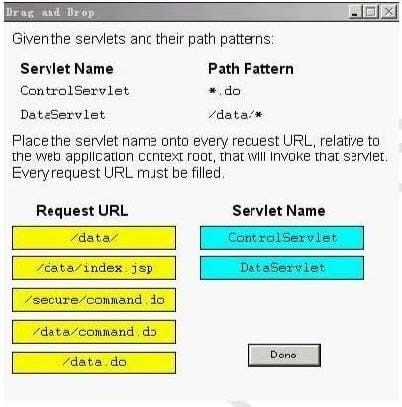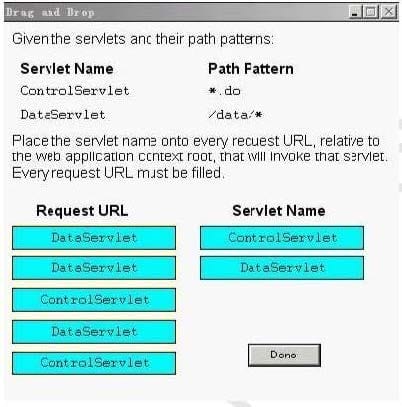1Z0-858 Online Practice Questions and Answers
Place the servlet name onto every request URL, relative to the web application context root, that will invoke that servlet. Every request URL must be filled.
Select and Place:

Select and Place:

You are building a web application that will be used throughout the European Union; therefore, it has significant internationalization requirements. You have been tasked to create a custom tag that generates a message using the java.text.MessageFormat class. The tag will take the resourceKey attribute and a variable number of argument attributes with the format, arg
generates:
The disk "MyDisk" contains 1247 file(s).
Which Simple tag class definition accomplishes this goal of handling a variable number of tag attributes?
A. public class MessageTag extends SimpleTagSupportimplements VariableAttributes {private Map attributes = new HashMap();public void setVariableAttribute(String uri,String name, Object value) {this.attributes.put(name, value);}// more tag handler methods}
B. The Simple tag model does NOT support a variable number of attributes.
C. public class MessageTag extends SimpleTagSupportimplements DynamicAttributes {private Map attributes = new HashMap();public void putAttribute(String name, Object value) {this.attributes.put (name, value);}// more tag handler methods}
D. public class MessageTag extends SimpleTagSupportimplements VariableAttributes {private Map attributes = new HashMap();public void putAttribute(String name, Object value) {this.attributes.put (name, value);}// more tag handler methods}
E. public class MessageTag extends SimpleTagSupportimplements DynamicAttributes {private Map attributes = new HashMap();public void setDynamicAttribute(String uri, String name,Object value) {this.attributes.put(name, value);}// more tag handler methods}
Which three are valid URL mappings to a servlet in a web deployment descriptor? (Choose three.)
A. */*
B. *.do
C. MyServlet
D. /MyServlet
E. /MyServlet/*
F. MyServlet/*.jsp
Which two actions protect a resource file from direct HTTP access within a web application? (Choose two.)
A. placing it in the /secure directory
B. placing it in the /WEB-INF directory
C. placing it in the /META-INF/secure directory
D. creating a
E. creating a
Given an EL function foo, in namespace func, that requires a long as a parameter and returns a Map, which two are valid invocations of function foo? (Choose two.)
A. ${func(1)}
B. ${foo:func(4)}
C. ${func:foo(2)}
D. ${foo(5):func}
E. ${func:foo("easy")}
F. ${func:foo("3").name}
Which two are characteristics of the Service Locator pattern? (Choose two.)
A. It encapsulates component lookup procedures.
B. It increases source code duplication and decreases reuse.
C. It improves client performance by caching context and factory objects.
D. It degrades network performance due to increased access to distributed lookup services.
Which three are described in the standard web application deployment descriptor? (Choose three.)
A. session configuration
B. MIME type mappings
C. context root for the application
D. servlet instance pool configuration
E. web container default port bindings
F. ServletContext initialization parameters
Given the security constraint in a DD:
101.
102.
103.
104.
105.
106.
107.
108.
109.
110.
And given that "MANAGER" is a valid role-name, which four are true for this security constraint? (Choose four.)
A. MANAGER can do a GET on resources in the /Bar/Baz directory.
B. MANAGER can do a POST on any resource in the /Bar/Baz directory.
C. MANAGER can do a TRACE on any resource in the /Bar/Baz directory.
D. DEVELOPER can do a GET on resources in the /Bar/Baz directory.
E. DEVELOPER can do only a POST on resources in the /Bar/Baz directory.
F. DEVELOPER can do a TRACE on any resource in the /Bar/Baz directory.
A JSP page needs to set the property of a given JavaBean to a value that is calculated with the JSP page. Which three jsp:setProperty attributes must be used to perform this initialization? (Choose three.)
A. id
B. val
C. name
D. param
E. value
F. property
G. attribute
Every page of your web site must include a common set of navigation menus at the top of the page. This menu is static HTML and changes frequently, so you have decided to use JSP's static import mechanism. Which JSP code snippet accomplishes this goal?
A. <%@ import file='/common/menu.html' %>
B. <%@ page import='/common/menu.html' %>
C. <%@ import page='/common/menu.html' %>
D. <%@ include file='/common/menu.html' %>
E. <%@ page include='/common/menu.html' %>
F. <%@ include page='/common/menu.html' %>
You have a new IT manager that has mandated that all JSPs must be refactored to include no scritplet code. The IT manager has asked you to enforce this. Which deployment descriptor element will satisfy this constraint?
A.
B.
C.
D.
You are creating a content management system (CMS) with a web application front-end. The JSP that displays a given document in the CMS has the following general structure:
1.
<%-- tag declaration --%>
2.
11.
99.
The citation tag must store information in the document tag for the document tag to generate a reference section at the end of the generated web page.
The document tag handler follows the Classic tag model and the citation tag handler follows the Simple tag model. Furthermore, the citation tag could also be embedded in other custom tags that could have either the Classic or Simple tag handler model.
Which tag handler method allows the citation tag to access the document tag?
A. public void doTag() {JspTag docTag = findAncestorWithClass(this, DocumentTag.class); ((DocumentTag)docTag).addCitation(this.docID);}
B. public void doStartTag() {JspTag docTag = findAncestorWithClass(this, DocumentTag.class); ((DocumentTag)docTag).addCitation(this.docID);}
C. public void doTag() {Tag docTag = findAncestor(this, DocumentTag.class); ((DocumentTag) docTag).addCitation(this.docID);}
D. public void doStartTag() {Tag docTag = findAncestor(this, DocumentTag.class); ((DocumentTag) docTag).addCitation(this.docID);}
Given:
6.
7.
<%="processing" %>
8.
and a custom tag handler for foo which extends TagSupport.
Which two are true about the tag handler referenced by foo? (Choose two.)
A. The doStartTag method is called once.
B. The doAfterBody method is NOT called.
C. The EVAL_PAGE constant is a valid return value for the doEndTag method.
D. The SKIP_PAGE constant is a valid return value for the doStartTag method.
E. The EVAL_BODY_BUFFERED constant is a valid return value for the doStartTag method.
Given in a single JSP page:
<%@ taglib prefix='java' uri='myTags' %> <%@ taglib prefix='JAVA' uri='moreTags' %>
Which two are true? (Choose two.)
A. The prefix 'java' is reserved.
B. The URI 'myTags' must be properly mapped to a TLD file by the web container.
C. A translation error occurs because the prefix is considered identical by the web container.
D. For the tag usage
A custom tag is defined to take three attributes. Which two correctly invoke the tag within a JSP page? (Choose two.)
A.
B.
C.
D.
E.
F.
G.

